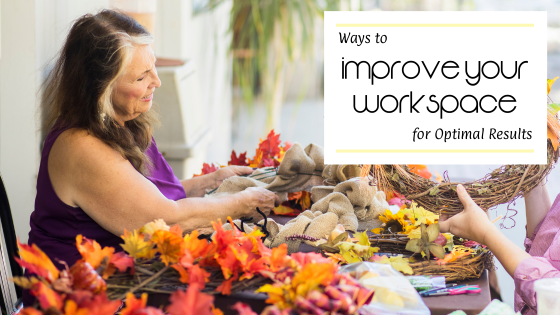Ways To Improve Your Workspace For Optimal Results
 A well-designed workspace is more essential than you might think. And for handmade product makers, it’s particularly important because your activities vary from a regular “desk job.” In this article, we’ll look at how to improve your workspace and make it a healthier and more enjoyable place to create.
A well-designed workspace is more essential than you might think. And for handmade product makers, it’s particularly important because your activities vary from a regular “desk job.” In this article, we’ll look at how to improve your workspace and make it a healthier and more enjoyable place to create.
Why A Well-Designed Workspace Is Important
I’m sure you’ve experienced having an organized and comfortable workspace and how it helps reduce stress and increase productivity. Unfortunately, when you’re busy, things can easily get out of hand and messy! That’s why knowing the additional benefits of an optimized work area is helpful and will motivate you to make some positive changes.
In fact, the psychological benefits of having a well-designed workspace are just as important as the practical advantages. Studies show that being able to optimize your workplace is linked to:
- Improved morale
- Higher satisfaction
- Increased motivation
- And enhanced creativity
Why does that happen? It’s because when you design and personalize your workspace, you gain a sense of control over your environment. This, in turn, allows for greater focus and clarity. All of which helps create a positive mindset, allowing for better problem-solving when faced with challenges or obstacles during the production process.
And, having a designated area specifically tailored to your unique style and needs fosters inspiration by providing visual cues that remind you why you started this journey in the first place – creating unique handmade items!
It’s clear that having an organized and inspiring work area filled with all the tools necessary to complete your projects efficiently is definitely a goal worth achieving. In the long run, it helps you stay motivated, remain focused on what needs to get done each day, and prevent you from getting thrown off by clutter or other distractions.
Makes complete sense, right? So let’s look at some ways you can make it happen.
Tips To Improve Your Workspace
Analysis is the First Step
Identifying your workspace needs is an important first step to creating a productive and efficient environment. As a maker, you require different types of spaces: an area for general office work, a shipping spot, and of course, production – to name a few.
Begin by figuring out what these areas are for you and the type of work that will be completed in each one. Even if you have only a small space to work with, designating tasks in different areas prevents setup and tear down as you switch between tasks.
Consider:
- How much space do you require for each activity?
- Are there specific requirements to complete these activities such as the availability of running water nearby or natural light?
- What about specialty equipment or close access to inventory?
Finally, define the budget for setting up your workspace. Investing in quality ergonomic furniture and tools will go a long way toward creating an efficient work environment. But, if your business can’t afford such things yet, start where you are and work on improvements as you grow.
- Resource: Ep. 298 – Set Up Your Home Office and Utilize Your Production Area for Optimal Physical Health
Designate a dedicated space
Once you have identified your needs and budget, it’s time to choose an area that will become your dedicated workspace.
When you’re working out of your home, a comfortable place that has good lighting and plenty of storage is optimal. If possible, try to make it separate from other living areas. For example, if you have access to a separate room, attic, or heated garage, this would be ideal. However, even if you just have a corner of your house designated as your workspace, that works too.
This will allow you to focus and stay in “work mode,” as well as have enough space to spread out materials and complete your projects.
Invest in ergonomic tools and furniture
The type of furniture and tools you choose should be tailored to your physical needs and the time spent doing each task. Investing in a good-quality chair with adjustable settings is highly recommended for keeping your body supported while working long hours.
Look for other items that are designed ergonomically too, such as a standing desk, or an adjustable laptop stand. Adding an ergonomic mouse, keyboard or adjustable monitor can also help to reduce fatigue and improve concentration.
Maybe even a task lamp that provides more focused lighting when needed. This can make it easier to see what you are working on and prevent eye strain.
If you use special tools for your craft, look for ones that are designed to be comfortable in your hands or find accessories that help relieve repetitive motion stress. Strain from tools can build up over time, so investing in items that ease the stress can make a big difference.
By considering the needs of your body when setting up your workspace, you can create an environment that makes it easier and more comfortable to get work done.
And lucky you! Since you’re a maker you’re up and moving around a lot. This is an added health bonus I bet you’ve never considered before. If you track steps, it’s surprising how moving around even in a small space racks up the numbers.
- Resource: Ep. 119 – Computer Tips to Keep You Safe
Declutter and organize your space
Whether it’s new or existing, a cluttered workspace is not only distracting but can also be dangerous. So, once you have your furniture and tools in place, clear out any unnecessary items and organize what’s left into designated areas.
This way it’s easier to find supplies when needed and gives your workspace a more professional feel. If possible, try to keep materials off of the floor (especially around power tools) and store them in labeled containers or bins.
Use shelves or drawers to keep items off of your work surface and make it easier to find what you need quickly. This helps minimize distractions and keep the workspace free from clutter.
It will also have a huge impact on your productivity. Taking a few minutes here and there to find what you’re looking for adds up to a lot of time in the course of a day. You’ll get that time back when everything has a place.
Take advantage of natural light & good air circulation
If possible, try to position your workspace near a window that provides natural light. This not only makes it easier to see what you’re doing but also offers psychological benefits as well. Natural light can help reduce stress and improve your mood, while also providing the energy needed to stay focused and energized throughout the day.
Also, make sure your workspace is properly ventilated with good air circulation. Especially if your craft involves any kind of chemicals, power tools, or paints. This will help to keep the air clean and prevent potential health risks from prolonged exposure. (I think that goes without saying but I wanted to include it here anyway.)
Add Personal Touches
Finally, don’t forget to add your own personal touches.
Whether it’s a piece of your own art or photos of family and friends, adding items that remind you of why you enjoy your craft will help you stay motivated and inspired each day.
Adding plants is also a great way to bring in some life and a sense of nature.
Take Time To Improve Your Workspace
These are just some of the ways that you can improve your workspace to make it more efficient and enjoyable. Creating an area that works for you is an important part of setting yourself up for success as a handmade business owner.
With some consideration of your needs and budget, you can put together a workspace that is both efficient and inspiring. This isn’t necessarily something that happens overnight. But over time, it can become an inspiring place to create and, since it’s your business, share with others your beautiful handmade products.
Hopefully, this helps you create the perfect workspace tailored to your needs. Enjoy the process and the process of bringing your own creative touch to your space!

